
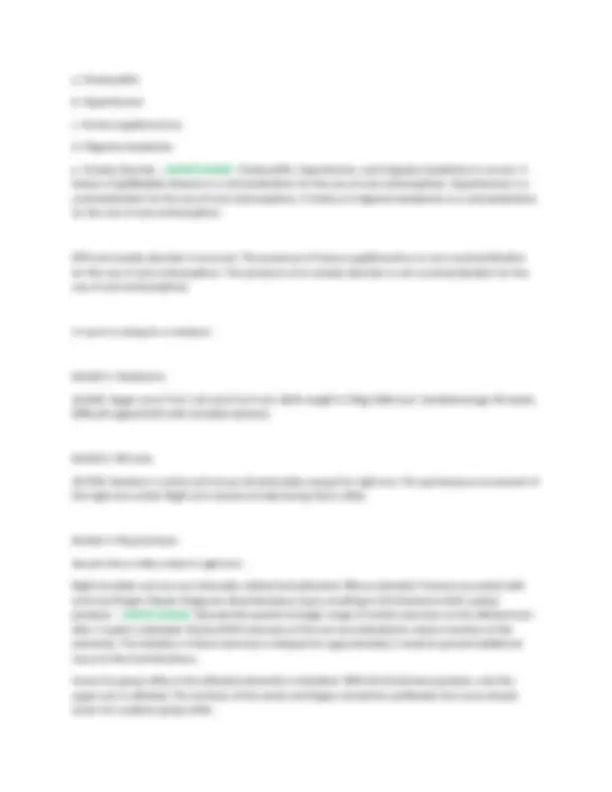
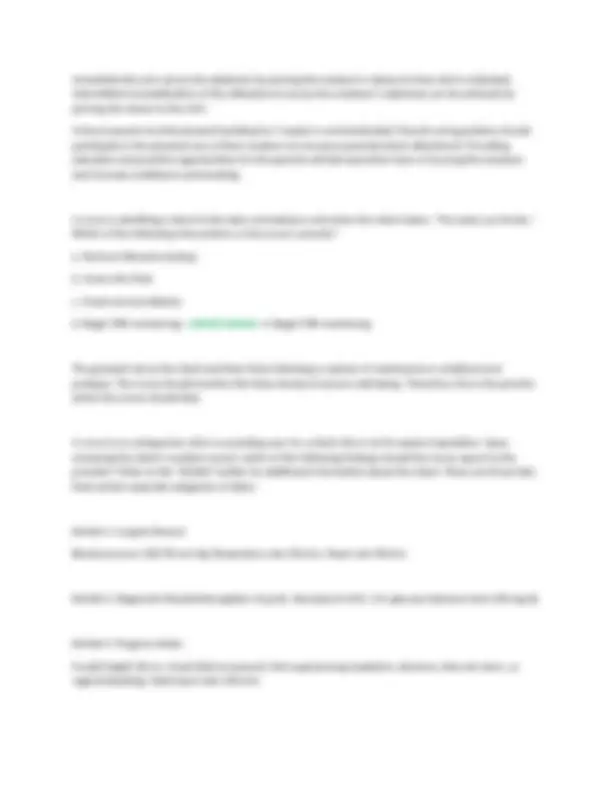
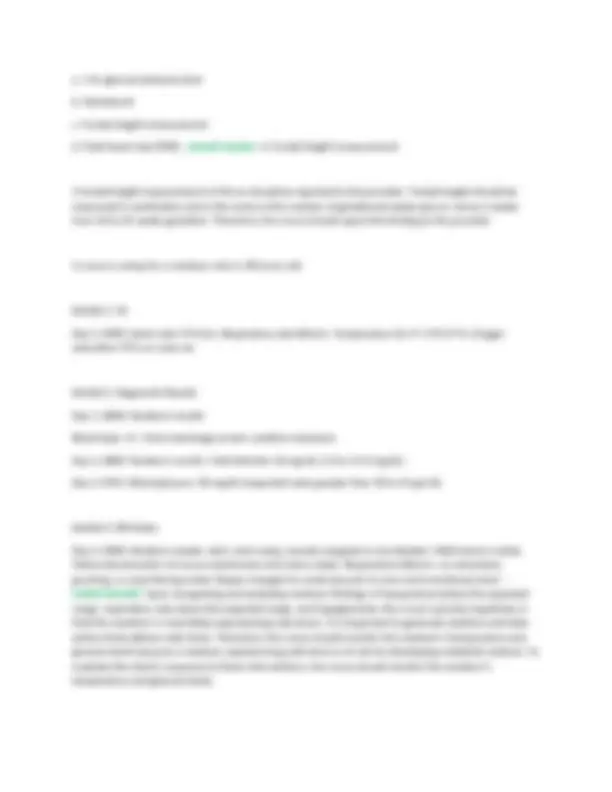
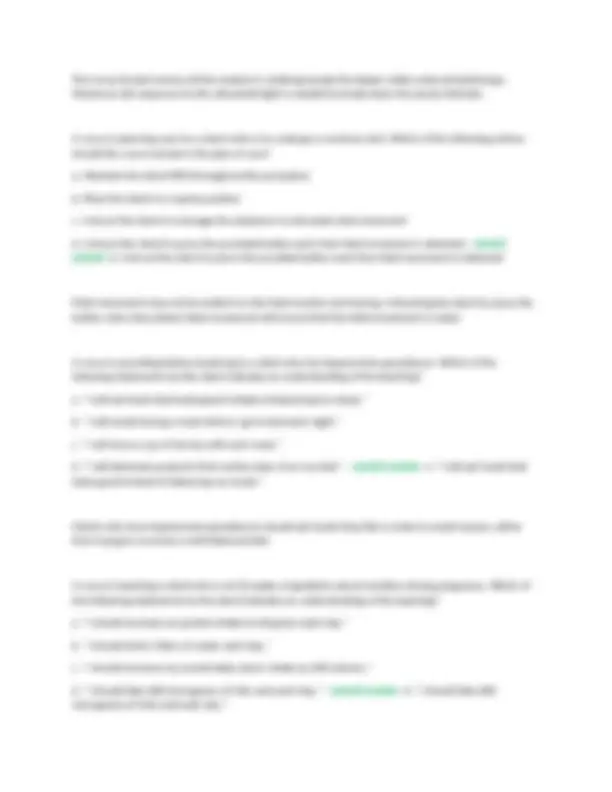
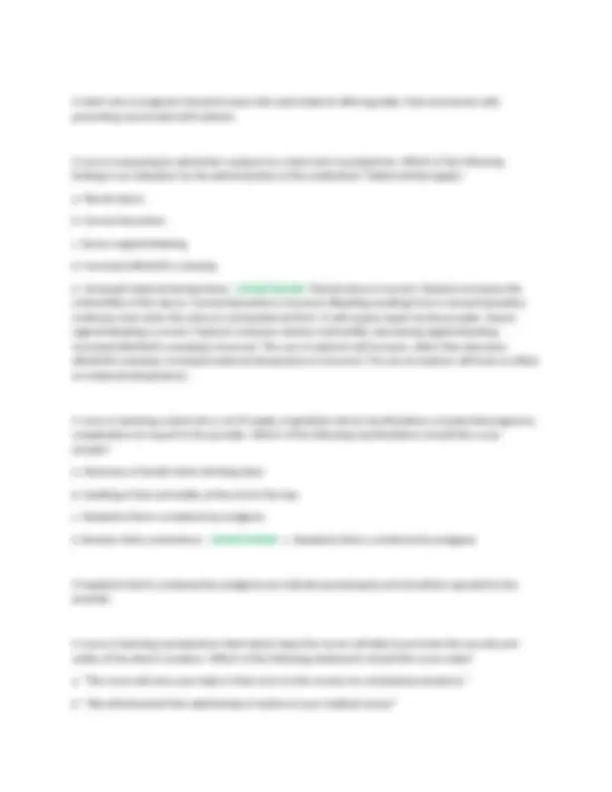
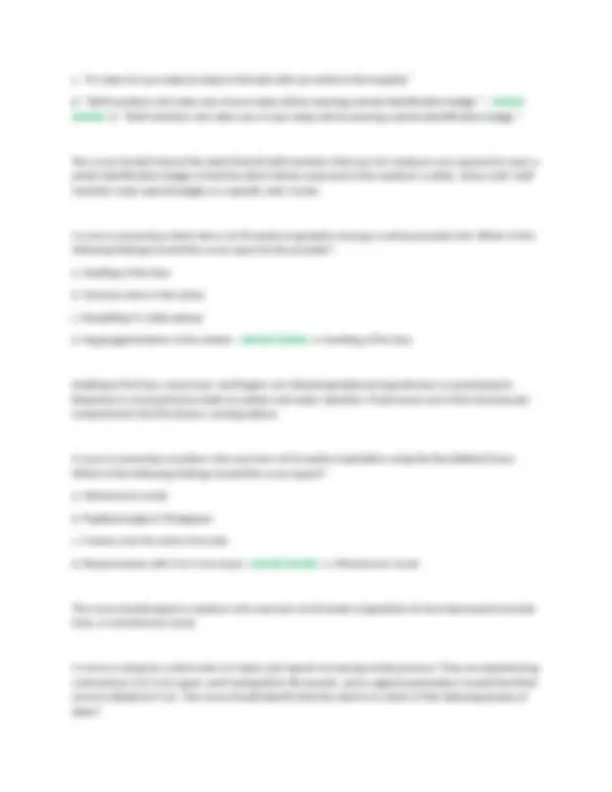
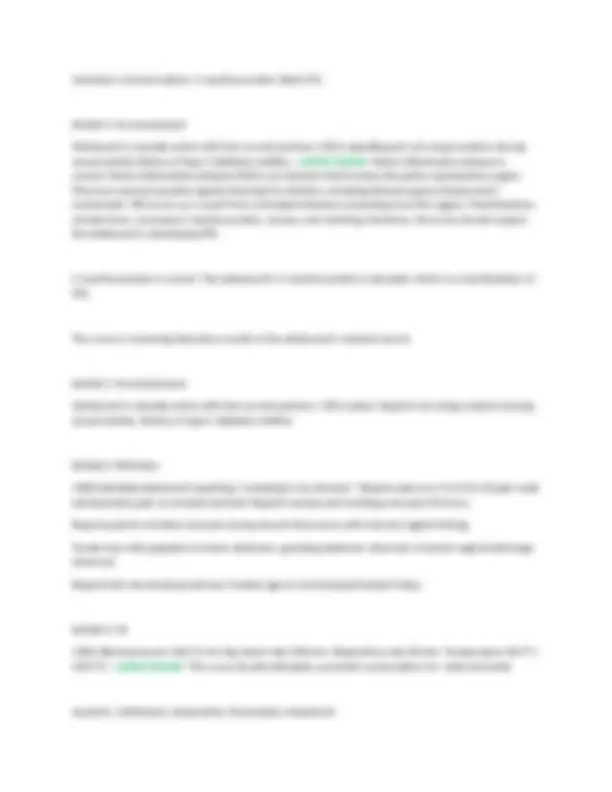
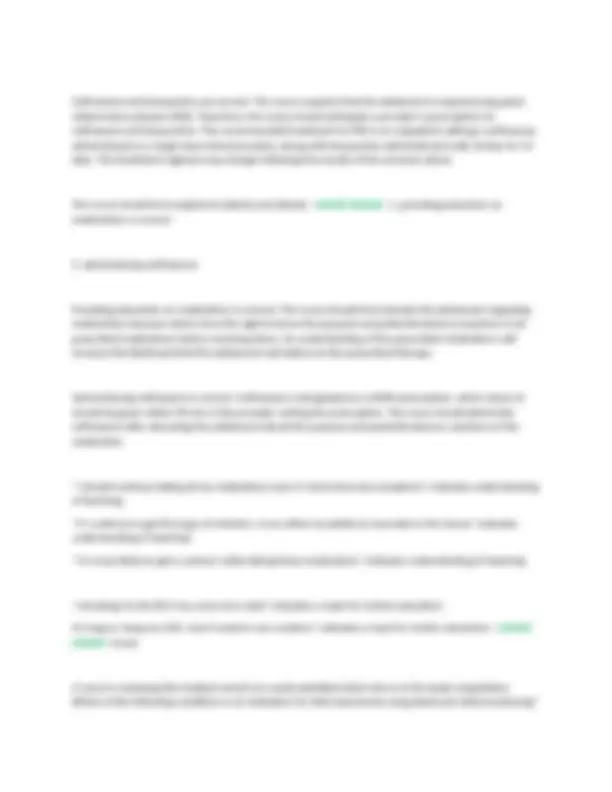
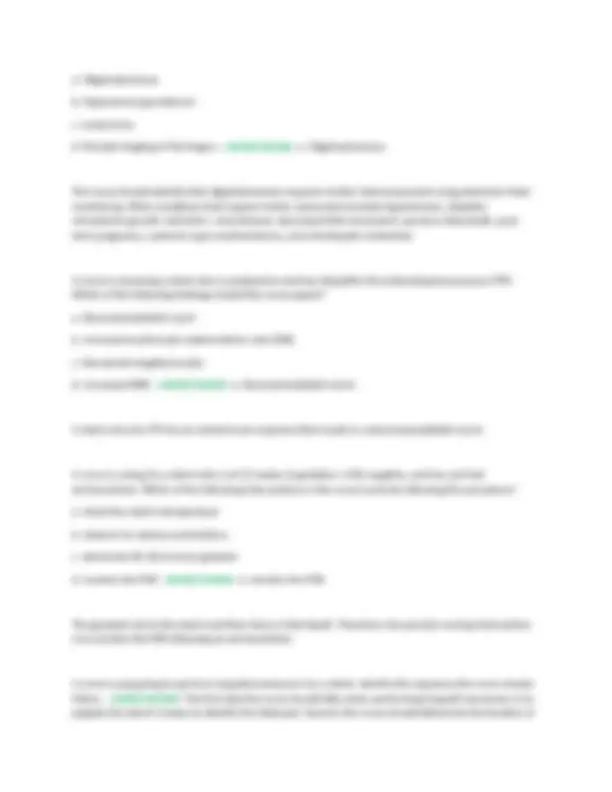
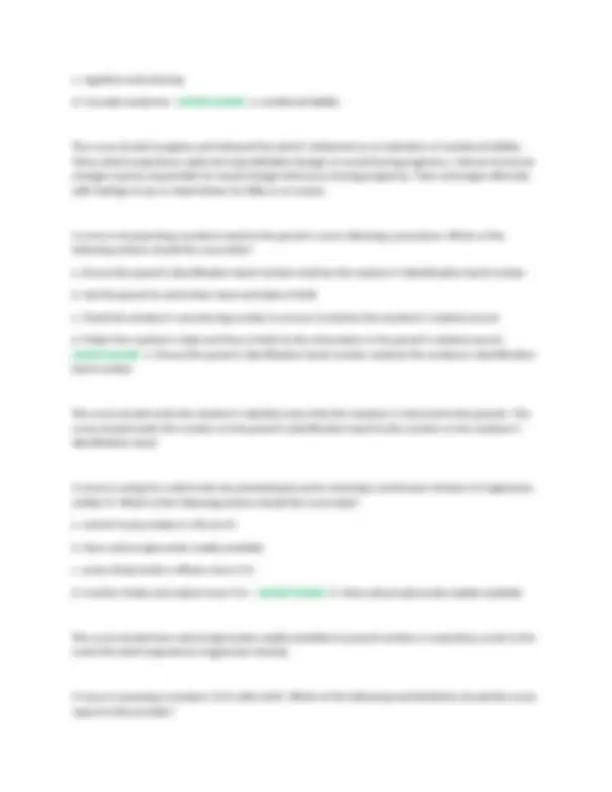
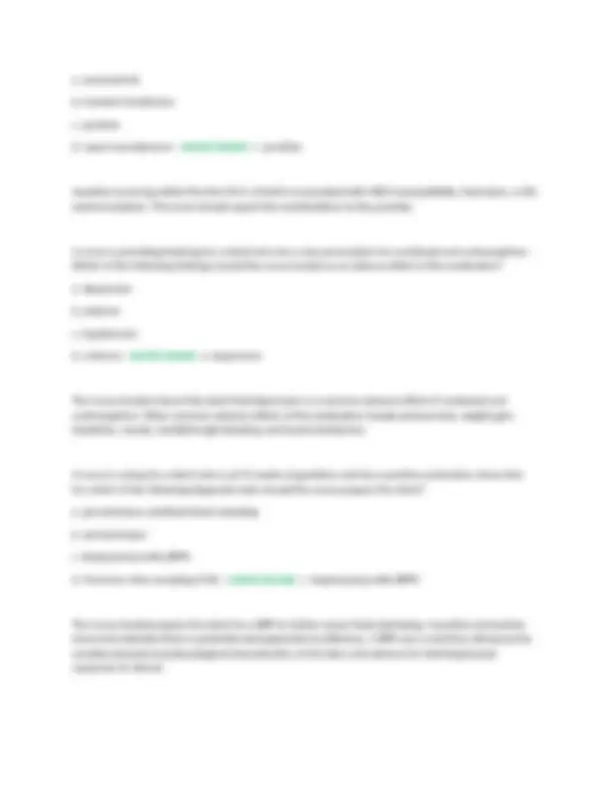
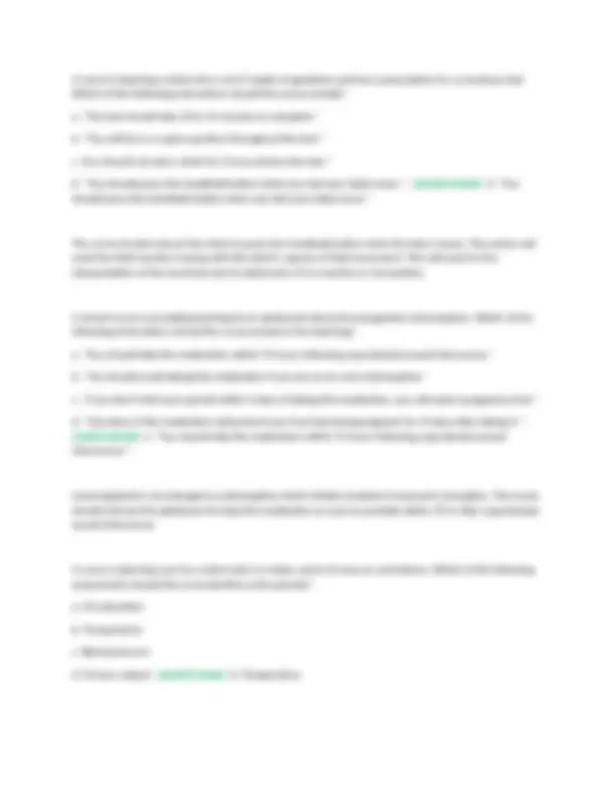
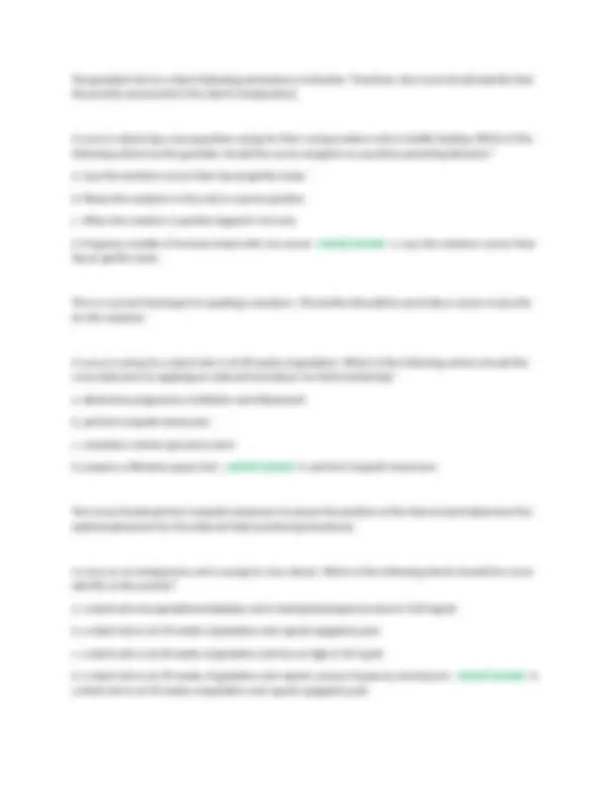
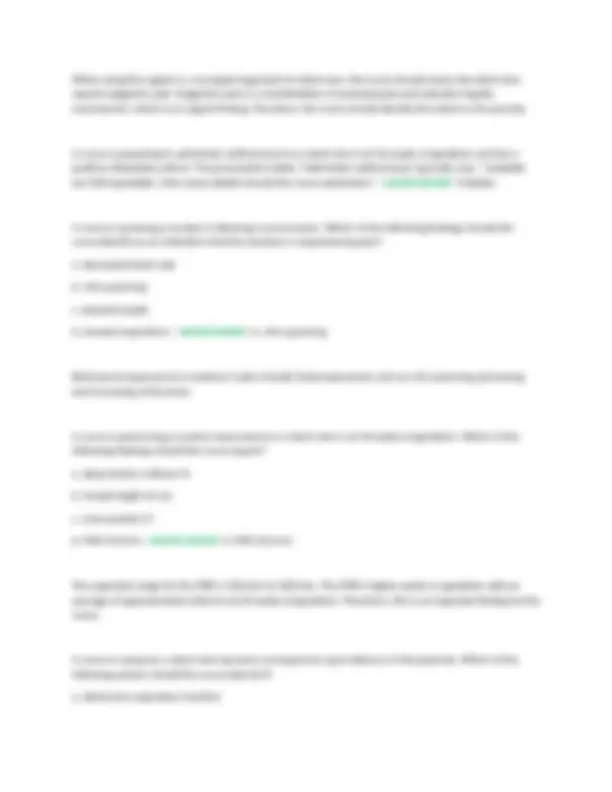
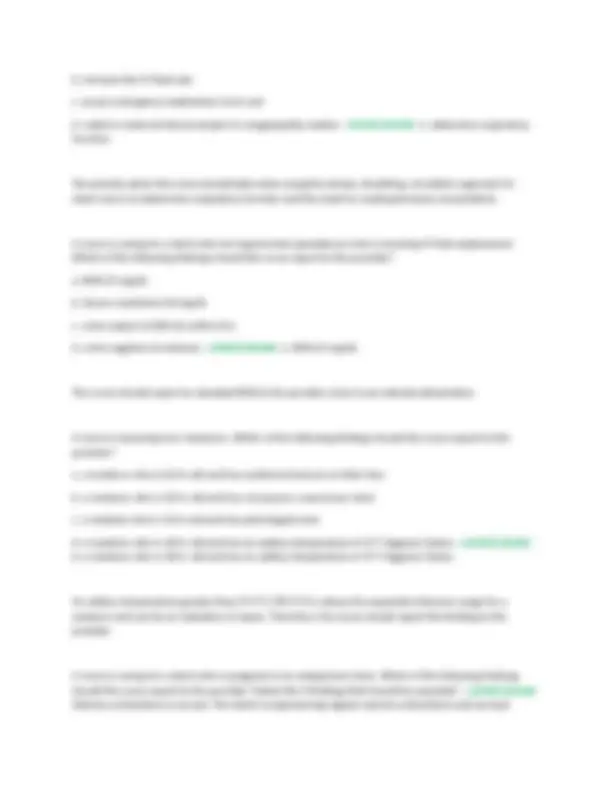
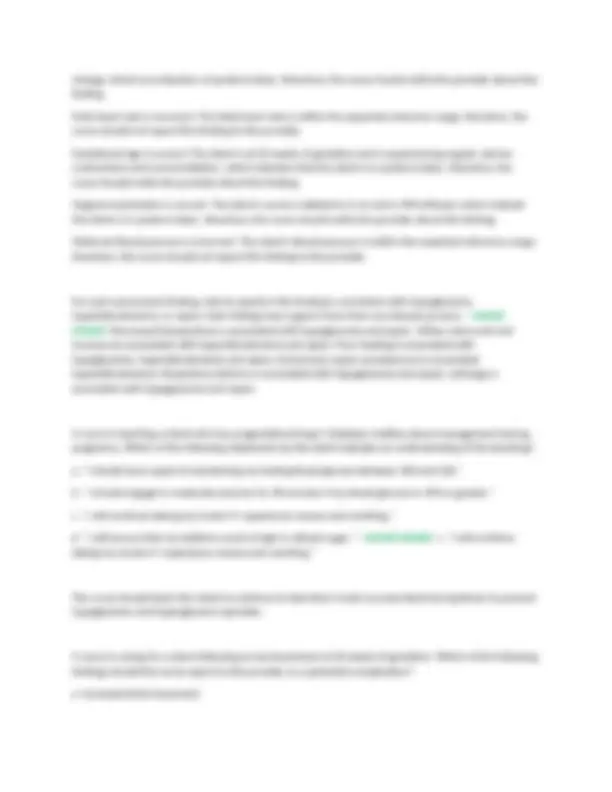
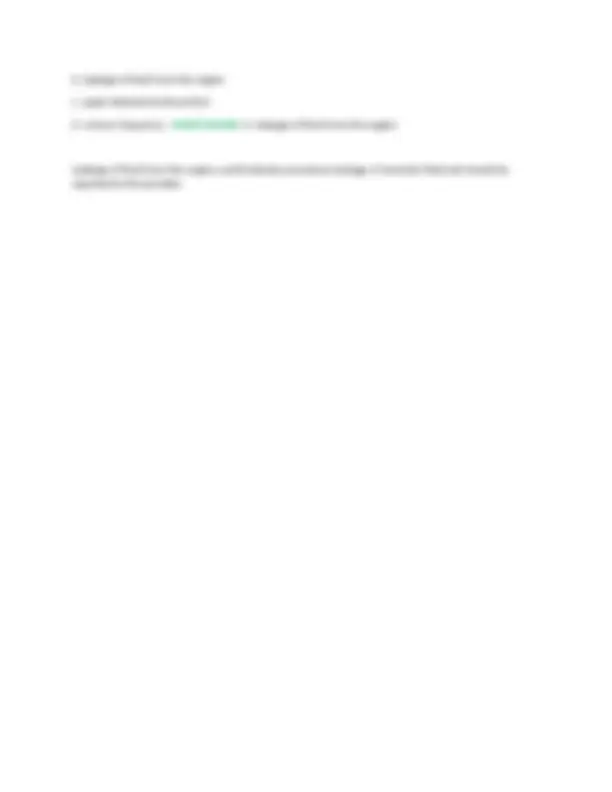


Study with the several resources on Docsity

Earn points by helping other students or get them with a premium plan


Prepare for your exams
Study with the several resources on Docsity

Earn points to download
Earn points by helping other students or get them with a premium plan
Community
Ask the community for help and clear up your study doubts
Discover the best universities in your country according to Docsity users
Free resources
Download our free guides on studying techniques, anxiety management strategies, and thesis advice from Docsity tutors
ATI RN Maternal Newborn A Exam Already Graded A+
Typology: Exams
1 / 25

This page cannot be seen from the preview
Don't miss anything!


















Exhibit 1: Medical hx Newborn delivered by repeat cesarean birth at 40 weeks of gestation. Birth weight 3,515 g (7 lb 12 oz) Apgar scores 8 at 1 min and 9 at 5 min. Maternal history of methadone use during pregnancy. Exhibit 2: VS @0700: Heart rate 156/min. Respiratory rate 58/min. Temperature 37.2° C (98.9° F) Oxygen saturation 98% on room air @1100: Heart rate 160/min. Respiratory rate 60/min. Temperature 37.3° C (99.2° F) Oxygen saturation 96% on room air Exhibit 3: Phys Exam Newborn is inconsolable with a high-pitched cry. Newborn sucks vigorously on pacifier but breastfeeds poorly. Respirations unlabored. Lungs sound clear on auscultation. Increased muscle tone with moderate to severe tremors when disturbed. Hyperactive Moro reflex noted. Several loose stools today. Exhibit 4: Diagnostic Results Maternal urine toxicology screen positive for opiates (-). Newborn urine toxicology screen positive for opiates (- - correct answer Respiratory findings is incorrect. The newborn's respiratory rate is within the expected reference range of 30 to 60/min. There is no indication the newborn has an alteration in respiratory status; therefore, this finding does not need to be reported to the provider. Temperature is incorrect. The newborn's temperature is within the expected reference range of 36.5° to 37.5° C (97.7° to 99.5° F). Therefore, this finding does not need to be reported to the provider. Oxygen saturation is incorrect. The newborn's oxygen saturation is within the expected reference range of greater than 94%; therefore, this finding does not need to be reported to the provider. Central nervous system findings is correct. The newborn is displaying inconsolability, high-pitched cry, increased muscle tone, tremors, hyperactive Moro reflex, and excessive sucking. These findings are manifestations of NAS and should be reported to the provider. Gastrointestinal findings is correct. The newborn is displaying poor feeding and loose stools. These findings are manifestations of NAS and should be reported to the provider. Exhibit 1: RN note @ 0900: Client reports a small amount of bright red blood in their underwear upon awakening. Client denies contractions or abdominal pain. External fetal monitor applied.
@0930: Client passed large amount of bright red blood from vagina. Denies pain. Uterine tone soft and nontender to palpation. Contraction pattern: no contractions noted. Fetal heart rate pattern: Fetal heart rate baseline 135/min. Moderate variability. No decelerations noted. Exhibit 2: VS @0900: Temperature 36.2°C (97.2° F)Pulse rate 78/min. Respiratory rate 20/min. Blood pressure 112/ mmHg. Fetal heart rate 132/min @0930: Pulse rate 82/min. Blood pressure 116/60 mmHg. Fetal heart rate 160/min Exhibit 3: Medical hx G4P3. 30 weeks gestation. Previous pregnancies delivered via cesarean section - correct answer When generating solutions, inserting a large bore intravenous catheter is indicated. Clients who have third trimester vaginal bleeding may experience a sudden hemorrhage and require fluid resuscitation or the administration of blood products. The nurse should weigh perineal pads. Weighing perineal pads after use will provide a more accurate assessment of the volume of blood loss that the client is experiencing. When generating solutions, the nurse should not administer methotrexate or assess for cervical dilation because it is contraindicated for this client. Methotrexate is an antimetabolite and folic acid antagonist which destroys rapidly dividing cells. It can be administered during pregnancy to medically resolve an ectopic pregnancy during the first trimester. Assessing cervical dilation is contraindicated for any pregnant client who is experiencing vaginal bleeding. Manipulation of the cervix during the examination may result in further damage to the placenta and compromise the well-being of the client and fetus. A nurse is assessing the newborn of a client who took selective serotonin reuptake inhibitor (SSRI) during pregnancy. Which of the following manifestations should the nurse identify as an indication of withdrawal from an SSRI? a. Large for gestational age b. Hyperglycemia c. Bradypnea d. Vomiting - correct answer d. Vomiting Expected manifestations associated with fetal exposure to SSRIs include irritability, agitation, tremors, diarrhea, and vomiting. These manifestations typically last 2 days. A nurse in a family planning clinic is caring for a client who requests an oral contraceptive. Which of the following findings in the client's history should the nurse recognize as a contraindication to oral contraceptives? (Select all that apply)
Immobilize the arm across the abdomen by pinning the newborn's sleeve to their shirt is indicated. Intermittent immobilization of the affected arm across the newborn's abdomen can be achieved by pinning the sleeve to the shirt. Instruct parents to limit physical handling for 2 weeks is contraindicated. Parents and guardians should participate in the physical care of their newborn to increase parental-infant attachment. Providing education and practice opportunities for the parents will decrease their fears of injuring the newborn and increase confidence and bonding. A nurse is admitting a client to the labor and delivery unit when the client states, "My water just broke." Which of the following interventions is the nurse's priority? a. Perform Nitrazine testing b. Assess the fluid c. Check cervical dilation d. Begin FHR monitoring - correct answer d. Begin FHR monitoring The greatest risk to the client and their fetus following a rupture of membranes is umbilical cord prolapse. The nurse should monitor the fetus closely to ensure well-being. Therefore, this is the priority action the nurse should take. A nurse in an antepartum clinic is providing care for a client who is at 26 weeks of gestation. Upon reviewing the client's medical record, which of the following findings should the nurse report to the provider? (Click on the "Exhibit" button for additional information about the client. There are three tabs that contain separate categories of data.) Exhibit 1: Graphic Record Blood pressure 130/78 mm Hg, Respiratory rate 20/min, Heart rate 90/min Exhibit 2: Diagnostic ResultsHemoglobin 12 g/dL, Hematocrit 34%, 1-hr glucose tolerance test 120 mg/dL Exhibit 3: Progress Notes Fundal height 30 cm, Good fetal movement, Not experiencing headache, dizziness, blurred vision, or vaginal bleeding, Fetal heart rate 110/min
a. 1-hr glucose tolerance test b. Hematocrit c. Fundal height measurement d. Fetal heart rate (FHR) - correct answer d. Fundal height measurement A fundal height measurement of 30 cm should be reported to the provider. Fundal height should be measured in centimeters and is the same as the number of gestational weeks plus or minus 2 weeks from 18 to 32 weeks gestation. Therefore, the nurse should report this finding to the provider. A nurse is caring for a newborn who is 48 hours old. Exhibit 1: VS Day 2, 0900: Heart rate 174/min, Respiratory rate 88/min, Temperature 36.1° C (97.0° F), Oxygen saturation 97% on room air Exhibit 2: Diagnostic Results Day 1, 0800: Newborn results Blood type: A+, Urine toxicology screen: positive marijuana Day 2, 0800: Newborn results, Total bilirubin 10 mg/dL (1.0 to 12.0 mg/dL) Day 2, 0915: Blood glucose: 38 mg/dL (expected value greater than 40 to 45 gm/dL Exhibit 3: RN Notes Day 2, 0900: Newborn awake, alert, and crying. Loosely wrapped in one blanket. Mild tremors noted. Yellow discoloration of mucus membranes and sclera noted. Respirations 88/min, no retractions, grunting, or nasal flaring noted. Diaper changed for small amount of urine and transitional stool. - correct answer Upon recognizing and analyzing newborn findings of temperature below the expected range, respiratory rate above the expected range, and hypoglycemia, the nurse's priority hypothesis is that this newborn is most likely experiencing cold stress. It is important to generate solutions and take actions that address cold stress. Therefore, the nurse should monitor the newborn's temperature and glucose levels because a newborn experiencing cold stress is at risk for developing metabolic acidosis. To evaluate the client's response to these interventions, the nurse should monitor the newborn's temperature and glucose levels.
The nurse is assessing a late preterm newborn. Which of the following manifestations is an indication of hypoglycemia? a. Hypertonia b. Increased feeding c. Hyperthermia d. Respiratory distress - correct answer d. Respiratory distress Late preterm newborns are at an increased risk for hypoglycemia due to decreased glycogen stores and immature insulin secretion. Respiratory distress is a manifestation of hypoglycemia. Other manifestations of hypoglycemia include an abnormal cry, jitteriness, lethargy, poor feeding, apnea, and seizures. The nurse is assessing a client who gave birth vaginally 12 hr ago and palpates their uterus to the right above the umbilicus. Which of the following interventions should the nurse perform? a. Reassess the client in 2 hr b. Administer simethicone c. Assist the client to empty their bladder d. Instruct the client to lie on their right side - correct answer c. Assist the client to empty their bladder The nurse should assist the client to empty their bladder because the assessment findings indicate that the client's bladder is distended. This can prevent the uterus from contracting, resulting in increased vaginal bleeding or postpartum hemorrhage. A nurse is developing a plan of care for a newborn who is to undergo phototherapy for hyperbilirubinemia. Which of the following actions should the nurse include in the plan? a. Feed the newborn 1 oz of water every 4 hr b. Apply lotion to the newborn's skin three times per day c. Remove all clothing from the newborn except the diaper d. Discontinue therapy if the newborn develops a rash. - correct answer c. Remove all clothing from the newborn except the diaper
The nurse should remove all the newborn's clothing except the diaper while under phototherapy. Maximum skin exposure to the ultraviolet light is needed to break down the excess bilirubin. A nurse is planning care for a client who is to undergo a nonstress test. Which of the following actions should the nurse include in the plan of care? a. Maintain the client NPO throughout the procedure b. Place the client in a supine position c. Instruct the client to massage the abdomen to stimulate fetal movement d. Instruct the client to press the provided button each time fetal movement is detected - correct answer d. Instruct the client to press the provided button each time fetal movement is detected Fetal movement may not be evident on the fetal monitor and tracing. Instructing the client to press the button when they detect fetal movement will ensure that the fetal movement is noted. A nurse is providing dietary teaching to a client who has hyperemesis gravidarum. Which of the following statements by the client indicates an understanding of the teaching? a. "I will eat foods that taste good instead of balancing my meals." b. "I will avoid having a snack before I go to bed each night." c. "I will have a cup of hot tea with each meal." d. "I will eliminate products that contain dairy from my diet." - correct answer a. "I will eat foods that taste good instead of balancing my meals." Clients who have hyperemesis gravidarum should eat foods they like in order to avoid nausea, rather than trying to consume a well-balanced diet. A nurse is teaching a client who is at 10 weeks of gestation about nutrition during pregnancy. Which of the following statements by the client indicates an understanding of the teaching? a. "I should increase my protein intake to 60 grams each day." b. "I should drink 2 liters of water each day." c. "I should increase my overall daily caloric intake by 300 calories." d. "I should take 600 micrograms of folic acid each day." - correct answer d. "I should take 600 micrograms of folic acid each day."
c. "It's okay for your baby to sleep in the bed with you while in the hospital." d. "Staff members who take care of your baby will be wearing a photo identification badge." - correct answer d. "Staff members who take care of your baby will be wearing a photo identification badge." The nurse should instruct the client that all staff members that care for newborns are required to wear a photo identification badge so that the client will be reassured of the newborn's safety. Some units' staff members wear special badges or a specific color scrubs. A nurse is assessing a client who is at 30 weeks of gestation during a routine prenatal visit. Which of the following findings should the nurse report to the provider? a. Swelling of the face b. Varicose veins in the calves c. Nonpitting 1+ ankle edema d. Hyperpigmentation of the cheeks - correct answer a. Swelling of the face Swelling of the face, sacral area, and fingers can indicate gestational hypertension or preeclampsia. Reduction in renal perfusion leads to sodium and water retention. Fluid moves out of the intravascular compartment into the tissues, causing edema. A nurse is assessing a newborn who was born at 26 weeks of gestation using the New Ballard Score. Which of the following findings should the nurse expect? a. Minimal arm recoil b. Popliteal angle of 90 degrees c. Creases over the entire foot side d. Raised areolas with 3 to 4 mm buds - correct answer a. Minimal arm recoil The nurse should expect a newborn who was born at 26 weeks of gestation to have decreased muscular tone, or minimal arm recoil. A nurse is caring for a client who is in labor and reports increasing rectal pressure. They are experiencing contractions 2 to 3 min apart, each lasting 80 to 90 seconds, and a vaginal examination reveals that their cervix is dilated to 9 cm. The nurse should identify that the client is in which of the following phases of labor?
a. Passive descent b. Active c. Early d. Descent - correct answer b. Active The nurse should identify that the client is in the active phase of labor. This phase is characterized by a cervical dilatation of 6 to 10 cm and contractions every 1.5 to 5 min, each lasting 40 to 90 seconds. A nurse in a clinic is caring for a 16-year-old adolescent. Exhibit 1: VS 1300: Blood pressure 118/72 mm Hg, Heart rate 100/min, Respiratory rate 20/min, Temperature 38.3° C (101° F) Exhibit 3: Hx and Physical Adolescent is sexually active with two current partners. IUD in place. Reports not using condoms during sexual activity. History of type 1 diabetes mellitus Exhibit 4: RN Notes 1300: Admitted adolescent reporting "cramping in my stomach." Reports pain as a 4 on 0 to 10 pain scale and describes pain as constant and dull. Reports nausea and vomiting over past 24 hours. Reports painful urination and pain during sexual intercourse with minimal vaginal itching. Tenderness with palpation to lower abdomen, guarding abdomen observed. Greenish vaginal discharge observed. Reports last menstrual period was 3 weeks ago as normal period lasted 4 days. - correct answer Abdominal assessment Vaginal discharge Temperature Dyspareunia A nurse in a clinic is caring for a 16-year-old adolescent.
Urinalysis, Cervical culture, C-reactive protein, Beta hCG Exhibit 3: Hx and physical Adolescent is sexually active with two current partners.IUD in placeReports not using condoms during sexual activity.History of type 1 diabetes mellitus - correct answer Pelvic inflammatory disease is correct. Pelvic inflammatory disease (PID) is an infection that involves the pelvic reproductive organs. There are several causative agents that lead to infection, including Neisseria gonorrhoeae and C. trachomatis. PID occurs as a result from untreated infections ascending from the vagina. Manifestations include fever, increased C-reactive protein, nausea, and vomiting; therefore, the nurse should suspect the adolescent is developing PID. C-reactive protein is correct. The adolescent's C-reactive protein is elevated, which is a manifestation of PID. The nurse is reviewing laboratory results in the adolescent's medical record. Exhibit 1: Hx and physical Adolescent is sexually active with two current partners. IUD in place. Reports not using condoms during sexual activity. History of type 1 diabetes mellitus Exhibit 2: RN Notes: 1300:Admitted adolescent reporting "cramping in my stomach." Reports pain as a 4 on 0 to 10 pain scale and describes pain as constant and dull. Reports nausea and vomiting over past 24 hours. Reports painful urination and pain during sexual intercourse with minimal vaginal itching. Tenderness with palpation to lower abdomen, guarding abdomen observed. Greenish vaginal discharge observed. Reports last menstrual period was 3 weeks ago as normal period lasted 4 days. Exhibit 3: VS 1300: Blood pressure 118/72 mm Hg, Heart rate 100/min, Respiratory rate 20/min, Temperature 38.3° C (101° F) - correct answer The nurse should anticipate a provider's prescription for: what and what acyclovir, ceftriaxone, doxycycline, fluconazole, imiquimod
Ceftriaxone and doxycycline are correct. The nurse suspects that the adolescent is experiencing pelvic inflammatory disease (PID); Therefore, the nurse should anticipate a provider's prescription for ceftriaxone and doxycycline. The recommended treatment for PID in an outpatient setting is ceftriaxone administered as a single dose intramuscularly, along with doxycycline administered orally 2x/day for 14 days. The treatment regimen may change following the results of the cervical culture. The nurse should first implement (blank) and (blank) - correct answer 1. providing education on medications is correct.
the fetal back. Third, the nurse should palpate for the fetal part presenting at the inlet. Finally, the nurse should palpate the cephalic prominence to identify the attitude of the head. A nurse is caring for a postpartum client who is receiving heparin via a continuous IV infusion for thrombophlebitis in their left calf. Which of the following actions should the nurse take? a. administer aspirin for pain b. maintain the client on bed rest c. massage the affected leg d. apply cold compresses to the affected calf - correct answer b. maintain the client on bed rest The client should remain on bed rest to decrease the risk of dislodging the clot, which could cause a pulmonary embolism. Elevation of the affected leg is recommended. A nurse in a prenatal clinic is assessing a group of clients. Which of the following clients should the nurse see first? a. A client who is at 11 weeks of gestation and reports abdominal cramping b. A client who is at 15 weeks of gestation and reports tingling and numbness in right hand c. A client who is at 20 weeks of gestation and reports constipation for the past 4 days d. A client who is at 8 weeks of gestation and reports having three bloody noses in the past week - correct answer a. A client who is at 11 weeks of gestation and reports abdominal cramping When using the urgent vs. nonurgent approach to client care, the nurse should determine that the priority finding is a client who is at 11 weeks of gestation and reports abdominal cramping. Abdominal cramping can indicate an ectopic pregnancy or manifestations of spontaneous abortion. The nurse should request that the provider see this client first. A nurse is caring for a client who is to receive oxytocin to augment their labor. Which of the following findings contraindicates the initiation of the oxytocin infusion and should be reported to the provider? a. Late decelerations b. Moderate variability of the FHR c. Cessation of uterine dilation d. Prolonged active phase of labor - correct answer a. Late decelerations
Late decelerations are indicative of uteroplacental insufficiency. Therefore, this is a contraindication for the administration of oxytocin and should be reported to the provider. A nurse is caring for a newborn who was transferred to the nursery 30 min after birth because of mild respiratory distress. Which of the following actions should the nurse take first? a. confirm the newborn's Apgar score b. verify the newborn's identification c. administer vitamin K to the newborn d. determine obstetrical risk factors - correct answer b. verify the newborn's identification When using the safety/risk reduction approach to client care, the first action the nurse should take is to verify the newborn's identity upon arrival to the nursery. A nurse is planning care for a client who is in labor and is requesting epidural anesthesia for pain control. Which of the following actions should the nurse include in the plan of care. a. Place the client in a supine position for 30 min following the first dose of anesthetic solution b. Administer 1000 mL of dextrose 5% in water prior to the first dose of anesthetic solution c. Monitor the client's blood pressure every 5 min following the first dose of anesthetic solution d. Ensure the client has been NPO 4 hr prior to the placement of the epidural and the first dose of anesthetic solution - correct answer c. Monitor the client's blood pressure every 5 min following the first dose of anesthetic solution The nurse should plan to obtain a baseline blood pressure prior to the initiation of anesthetic solution. The nurse should then continue to monitor the client's blood pressure every 5 to 10 min to assess for maternal hypotension caused by the anesthetic solution. A nurse in the antepartum clinic is assessing a client's adaptation to pregnancy. The client states that they are "happy one minute and crying the next." The nurse should interpret the client's statement as an indication of which of the following? a. emotional lability b. focusing phase
a. acrocyanosis b. transient strabismus c. jaundice d. caput succedaneum - correct answer c. jaundice Jaundice occurring within the first 24 hr of birth is associated with ABO incompatibility, hemolysis, or Rh- isoimmunization. The nurse should report this manifestation to the provider. A nurse is providing teaching for a client who has a new prescription for combined oral contraceptives. Which of the following findings should the nurse include as an adverse effect of this medication? a. depression b. polyuria c. hypotension d. urticaria - correct answer a. depression The nurse should instruct the client that depression is a common adverse effect of combined oral contraceptives. Other common adverse effects of the medication include amenorrhea, weight gain, headache, nausea, breakthrough bleeding, and breast tenderness. A nurse is caring for a client who is at 41 weeks of gestation and has a positive contraction stress test. For which of the following diagnostic tests should the nurse prepare the client? a. percutaneous umbilical blood sampling b. amnioinfusion c. biophysical profile (BPP) d. Chorionic villus sampling (CVS) - correct answer c. biophysical profile (BPP) The nurse should prepare the client for a BPP to further assess fetal well-being. A positive contraction stress test indicates there is potential uteroplacental insufficiency. A BPP uses a real time ultrasound to visualize physical and physiological characteristics of the fetus and observe for fetal biophysical responses to stimuli.
A nurse is teaching a client who is at 37 weeks of gestation and has a prescription for a nonstress test. Which of the following instructions should the nurse include? a. "The test should take 10 to 15 minutes to complete." b. "You will lay in a supine position throughout the test." c. You should not eat or drink for 2 hours before the test." d. "You should press the handheld button when you feel your baby move." - correct answer d. "You should press the handheld button when you feel your baby move." The nurse should instruct the client to press the handheld button when the fetus moves. This action will mark the fetal monitor tracing with the client's reports of fetal movement. This will assist in the interpretation of the nonstress test to determine if it is reactive or nonreactive. A school nurse is providing teaching to an adolescent about levonorgestrel contraception. Which of the following information should the nurse include in the teaching? a. "You should take the medication within 72 hours following unprotected sexual intercourse." b. "You should avoid taking this medication if you are on an oral contraceptive." c. "If you don't start your period within 5 days of taking this medication, you will need a pregnancy test." d. "One dose of this medication will prevent you from becoming pregnant for 14 days after taking it." - correct answer a. "You should take the medication within 72 hours following unprotected sexual intercourse." Levonorgestrel is an emergency contraceptive which inhibits ovulation to prevent conception. The nurse should instruct the adolescent to take this medication as soon as possible within 72 hr after unprotected sexual intercourse. A nurse is planning care for a client who is in labor and is to have an amniotomy. Which of the following assessments should the nurse identify as the priority? a. O2 saturation b. Temperature c. Blood pressure d. Urinary output - correct answer b. Temperature